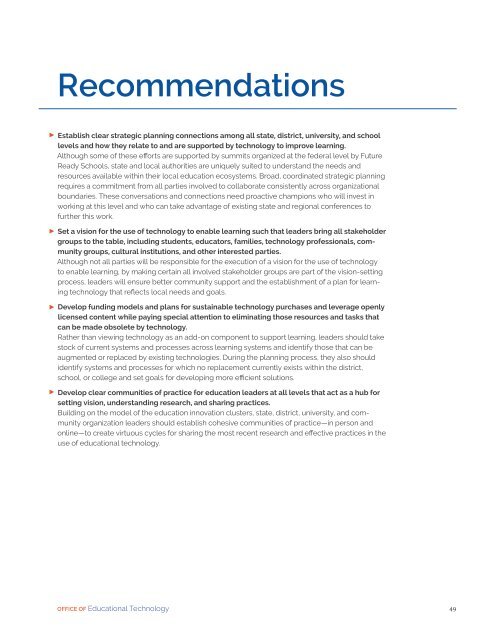Future Ready Learning
7m3sdJ
7m3sdJ
Create successful ePaper yourself
Turn your PDF publications into a flip-book with our unique Google optimized e-Paper software.
Recommendations<br />
Establish clear strategic planning connections among all state, district, university, and school<br />
levels and how they relate to and are supported by technology to improve learning.<br />
Although some of these efforts are supported by summits organized at the federal level by <strong>Future</strong><br />
<strong>Ready</strong> Schools, state and local authorities are uniquely suited to understand the needs and<br />
resources available within their local education ecosystems. Broad, coordinated strategic planning<br />
requires a commitment from all parties involved to collaborate consistently across organizational<br />
boundaries. These conversations and connections need proactive champions who will invest in<br />
working at this level and who can take advantage of existing state and regional conferences to<br />
further this work.<br />
Set a vision for the use of technology to enable learning such that leaders bring all stakeholder<br />
groups to the table, including students, educators, families, technology professionals, community<br />
groups, cultural institutions, and other interested parties.<br />
Although not all parties will be responsible for the execution of a vision for the use of technology<br />
to enable learning, by making certain all involved stakeholder groups are part of the vision-setting<br />
process, leaders will ensure better community support and the establishment of a plan for learning<br />
technology that reflects local needs and goals.<br />
Develop funding models and plans for sustainable technology purchases and leverage openly<br />
licensed content while paying special attention to eliminating those resources and tasks that<br />
can be made obsolete by technology.<br />
Rather than viewing technology as an add-on component to support learning, leaders should take<br />
stock of current systems and processes across learning systems and identify those that can be<br />
augmented or replaced by existing technologies. During the planning process, they also should<br />
identify systems and processes for which no replacement currently exists within the district,<br />
school, or college and set goals for developing more efficient solutions.<br />
Develop clear communities of practice for education leaders at all levels that act as a hub for<br />
setting vision, understanding research, and sharing practices.<br />
Building on the model of the education innovation clusters, state, district, university, and community<br />
organization leaders should establish cohesive communities of practice—in person and<br />
online—to create virtuous cycles for sharing the most recent research and effective practices in the<br />
use of educational technology.<br />
OFFICE OF Educational Technology<br />
49



